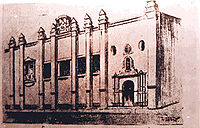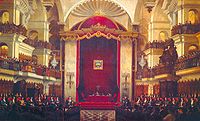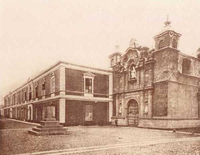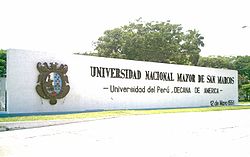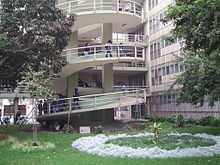- National University of San Marcos
-
National University of San Marcos Universidad Nacional Mayor de San Marcos 
Latin: Academia S. Marci Vrbis Regvm in Perv Motto Universidad del Perú,
Decana de AméricaMotto in English University of Peru,
Dean of the AmericasEstablished May 12, 1551 Type Public Rector Pedro Cotillo Zegarra Academic staff 2559 (full time)
674 (part time)Undergraduates 29,710 Postgraduates 3,549 Location Lima, Peru
Coordinates: 12°03′30″S 77°05′00″W / 12.05833°S 77.0833333°WCampus Urban
170 acres (69 ha) (Main campus)Colors Magenta
White
Steel blueMascot Lion Website www.unmsm.edu.pe 
The National University of San Marcos (Spanish: Universidad Nacional Mayor de San Marcos, UNMSM) is the most important and respected higher-education institution in Peru.[1][2] Its main campus, the University City, is located in Lima. It was chartered on May 12, 1551 by a royal decree signed by Charles V, Holy Roman Emperor, which makes it the oldest officially established university in the Americas and, as such, one of the oldest universities in the world.[3] Academically, the University of San Marcos ranks first in Peru.[4][5][6][7][8]
San Marcos has 60 academic-professional schools,[9] organized into 20 faculties, and these, in turn, into 6 academic areas. All the faculties offer undergraduate and graduate degrees. The student body consists of over 30,000 undergraduate and 4,000 graduate students from all the country as well as some international students. The university has also a number of public institutions under its government such as the San Marcos Cultural Center and the Museum of Natural History of Lima.
San Marcos' prestige in Latin America mainly arises from its renowned faculty and alumni. It is the only university in Peru with a Nobel Prize laureate among its alumni: Mario Vargas Llosa (Literature). San Marcos is also recognized for the quality of its curricular contents, its very competitive admission process, as well as for being a leading center of scientific research.[10] Several Peruvian and Latin American influential thinkers, researchers, scientists, politicians and writers have studied there, which underscores San Marcos' leading role as an educational institution in the history of Peru and the world.
Contents
History
The origins of San Marcos National University marks the start of higher education in Peru, which dates back to the General Studies carried out at the chambers of the Dominican Order’s Convent of Our Lady of the Rosary, near the Plaza de Armas circa 1549. Its main objective was to meet the training and education needs of the clergy in the newly conquered territory of the Spanish Empire. Subsequently, the Lima’s town council sent to Spain friar Tomas of San Martin and Captain Juan Jeronimo de Aliaga, who - due largely to the efforts of the former – obtained the order for the foundation of the university from Emperor Carlos I of Spain and V of the Holy Roman Empire and his mother, Queen Joanna of Castile, daughter of the Catholic Monarchs. Therefore, by Royal Decree issued on May 12 of 1551 in Valladolid, the Royal University of the City of Kings was officially founded. At the time, it was also called Real y Pontificia Universidad de Lima.[9] [10] Reading the royal decree, formally authorizing the operation of the "Universidad de Lima", its mission is stated as "indoctrinate residents of these lands in the Christian faith and submission to the King". With this principle, the university officially began operations on January 2, 1553, in the Chapter House of the Convent of Our Lady of the Rosary of the Dominican Order under the leadership of its first chancellor friar Juan Bautista of la Roca. The initial instruction was delivered by Andres Carrillo and Cosme Cianca and Corona, both under the supervision of the chancellor.
The fact that it was essentially strictly oriented towards monastic life added to the elitism and conservatism of the Dominicans, as well as the continued decline of members of other congregations, caused the loss of the Dominicans’ predominance and also generated a reaction on the part of the secular teachers. The demand for greater openness led to ask The Royal Audiencia compliance with the Royal Decree of Graces of 1570, which granted the free election of the chancellor by the teachers of the school’s senate. The Viceroy Francisco de Toledo, resolved the complaint with the election of Dr. Pedro Fernandez Valenzuela on May 11, 1571, the first secular chancellor and a significant departure from the previous religiously oriented leadership. The legitimacy of the elections was confirmed by Papal bull Exponi Nobis by Saint Pius V on July 25, 1571, after receiving the exequatur from the Council of the Indies. On the bull, ecclesiastic courts were excluded by declaring it «absolves friars, lecturers, teachers, students and any of you of all and any censure, sentence and ecclesiastic penalty, for any contracted reason or cause». At the same time, the university becomes pontifical, changing its name to Royal and Pontifical University of Lima the City of Kings. After this reform, the university moved to its second location outside the walls of San Marcelo, where the Convent of the Agustinians had functioned. [9] On September 6, 1574 the official name of the university is chosen by drawing lots. Saint Mark the evangelist is taken as saint patron and the name is changed to Royal and Pontifical University of Saint Mark. [10] In 1575 the university is once more relocated. This time it’s moved to the former Plaza del Estanque, later called Plaza de la Inquisicion, where the Congress of Peru is currently located [2]. Here, it will continue functioning throughout the rest of the Viceroyalty period of Peruvian history.
The University of Lima, now officially named "University of San Marcos, began its work in the colonial era to the powers of Theology and ArtsThen the fees would be created Laws and MedicineNevertheless academically when the standards governing in Spain, or start their teaching duties Philosophy as the basis for any college. The November 27 of 1579 teachers asked the king Philip II the institution of courts that ruled on the University of Salamanca, A legal medieval-history of the current university autonomy, which empowered the president to the exclusion of ordinary courts, have civil and criminal jurisdiction over members of the faculty. In 1581, Then the absolute presence of lay rectors between 1571 and 1581, Viceroy Francisco de Toledo authorized clergy and laity to be elected, and both sectors alternately ruled the University of San Marcos, during the colonial period until 1820.[11]
Support for the secularization of the University of San Marcos as the viceroy Francisco de Toledo and the institution of courts exercising its rector, and also exercised the rector of San Carlos Real ConvictorioFounded the July 7 of 1770Were the decisive factors that led to the university community, students and teachers, towards achieving the ideal Bolognese who viewed the university as a space of freedom. Thus began the birth of the intellectual climate that made possible the questioning and criticism of the colonial system. Thus, both the University of San Marcos as the "College of Law and Literature of San Carlos"And"Medical College of San Fernando"(Incorporated into it later) began to be monitored closely by the Viceroy, By virtue of holding teachers and students suspected of and manage envisions the end of colonial rule and the emergence of what is now the Republic of Peru.[12] Presumably were the privileges enjoyed by both the university and the Convictorio, allowing the entry of the thought of enlightenment in their cloisters, and arise in the theoretical and doctrinal approaches to the ideological emancipation. In 1813During the administration of Viceroy José Fernando de AbascalWas established Faculty of Medicine "San Fernando" (a tribute to King Ferdinand VII of Spain) In the Plaza de Santa Ana now in the Plaza Italia-space occupied by the Ministry of Government, the power base was formed in the College of Medicine of the same name.
The First Constitutional Congress of Peru, Which he defined as reality and as a project to the new Republic of PeruWas chaired initially by whom was rector University of San Marcos, Don Toribio Rodríguez de Mendoza; Of the 64 constituent members, were 54 and the San Marcos CarolineAnd the place where he met this great assembly was the Chapel of the University of San Marcos.[10] Today, the Congress of the Republic of Peru still operating at that same location and the current Casona de San MarcosWas the local San Carlos Real Convictorio. In 1840 Schools "San Carlos" and "San Fernando", are assumed by the University of San Marcos. During the administration of Marshal Ramón Castilla, San Marcos was officially empowered to approve new universities and newly created control.[12] Along the nineteenth century the location of the University of San Marcos was stripped of his university functions, being more frequent use of the sessions Chamber of Deputies and the core activities of Congress of the Republic of Peru. However, the lack of care and the partial abandonment of its functions had their original academic atmosphere began to suffer a significant deterioration since the old local university received little attention on the eve of the installation of Congress or special events.[10]
The exponential growth of the city during the industrial revolution of nineteenth century addition to the efforts of then President of Peru Manuel Pardo to improve architecture and urban planning City during 1870 forced the university to move to a new campus adjacent to the old monastery Jesuit where he lived the San Carlos Real Convictorio (now this is called La Casona del Parque Universitario or simply La Casona de San Marcos). In those years, San Marcos became the "Alma Mater"From other universities Peru and America; It was formed to protect the core scientific and cultural institutions during the Viceroyalty and the same during the Republic; Their graduates, so students were part of missions established universities Hispano.
In 1878During the administration of Manuel Pardo, Was issued the General Rules of Public Instruction, universities instituting the concept of major and minor, corresponding to the first title in San Marcos and universities in Arequipa and Cusco the second. During the Pacific War and specifically during the occupation of Lima by troops Chilean, Are taken from the university of art objects and cultural property, to be brought to Chile by boat.[10] After the war and coping outcomes, by law 1901 states that the Peruvian college corresponds to the "Universidad Nacional Mayor de San Marcos" and Under Trujillo, Cusco, Arequipa to which later joined the Catholic and Technical Schools.[12]
At the end of the decade 1960, At the request of an even larger space, some faculties of the university began to move to an area now called Ciudad Universitaria. This new campus is close to the Maranga Culture huacas the same as the university took great pains to restore and protect, having been partially destroyed during construction of the Avenida Venezuela in the 1940s.
San Fernando: Although this power belongs to the Department of Health Sciences is also considered as the second campus of the University of San Marcos. It was originally located in the Square PondThen thanks to the efforts of Dr. Hipolito Unanue had its own premises in the old Plaza de Santa Ana (now the Plaza Italia) until its facilities were moved to late nineties of the nineteenth century to the local Avenida GrauIn the Historic Center of Lima.
From the legal standpoint regarding ownership, UNMSM first belonged to the royal state, and since 1821 the young Peruvian republic received as an inheritance. The current status of the university was issued on 22 September 1984.
On the importance of the University of San Marcos in the historic fabric of Peru and America, the Liberator Simón Bolívar, Said the day he received the degree of Doctor Honoris Causa (Ino Truque jure):
Oldest University of the Americas
As mentioned above, San Marcos was officially established by a royal decree (signed by Charles V, Holy Roman Emperor) on May 12, 1551, and since then it has operated without interruption. Hence, it is known as the Dean of America ("dean" in the sense of "oldest member"). San Marcos also claims that according to the Archivo General de Indias, a famous Spanish repository of documents on the former colonies in the sixteenth to eighteenth centuries, there were no official records authorizing any other university or higher-education institution before 1551. [1] The National Autonomous University of Mexico (UNAM) was chartered the same year as San Marcos (by a royal decree of September 21, 1551), as the Royal University of the New Spain, which makes it the second oldest in the Americas (but was closed from 1867–1910).
On the other hand, the Autonomous University of Santo Domingo was founded in 1538, but was not officially recognized by Royal Decree until 1558, and, as many other universities in the Americas that closed during independence wars and other political conflicts, it was closed due to the occupations of the Dominican Republic by Haiti and then the United States.
Therefore, it is unquestionable that San Marcos is the oldest university to be officially established in the Americas.
Organisation
Government
The university was originally headed by members of the clergy. During the Enlightenment, Bourbon reforms transformed it into a secular institution. Nowadays, the university is governed by:
- The University Council
- The University Assembly (composed of professors and students, with the latter holding a third of the seats).
- The Rector (president)
- Two Vice-Rectors:
- Academic Vice-Rector
- Vice-Rector of investigation.
Academic areas and faculties
The original faculties at San Marcos were Theology, Arts and Law; Jurisprudence, and Medicine were added later in the colonial period. The Faculty of Natural Sciences and the Faculty of Economics and Commerce were created in the mid-19th century. The Faculty of Science was subdivided by specialities in the 20th century. The Faculty of Theology was closed in 1935.
In the mid-1990s San Marcos' departments were grouped into four academic blocks. Nowadays, San Marcos' falculties are grouped into 6 academic areas, as shown below.
Health sciences
Academic area I: Health sciences
- Faculty of Human Medicine:
- Human Medicine
- Midwifery
- Nursing
- Medical Technology
- Clinical laboratory & Pathology (merged)
- Physical therapy & Rehabilitation programme (merged)
- Radiology
- Occupational therapy
- Nutrition
- Faculty of Pharmacy and Biochemistry:
- Pharmacy & Biochemistry (merged)
- Food science
- Toxicology
- Faculty of Dentistry:
- Faculty of Veterinarian Medicine:
- Faculty of Psychology:
Humanities
Academic area II: Humanities
- Faculty of Letters and Human sciences:
- Literature
- Philosophy
- Linguistics
- Social Communication
- Art
- Library and Information Science
- Restoration & Conservation (merged)
- Dance
- Faculty of Education:
- Kindergarten teaching
- Elementary School teaching
- High School teaching
- Physical Education
Social sciences
Academic area III: Social sciences
- Faculty of Law and Political science:
- Faculty of Social sciences:
Basic sciences
Academic area IV: Basic sciences
- Faculty of Chemistry and Chemical engineering:
- Faculty of Biological sciences:
- Biology
- Genetics & Biotechnology (merged)
- Microbiology & Parasitology (merged)
- Faculty of Physical sciences:
- Faculty of Mathematical sciences:
- Mathematics
- Statistics
- Scientific Computing
- Operations Research
Engineering
Academic Block V: Engineering
- Faculty of Chemistry and Chemical engineering:
- Chemical engineering
- Agroindustrial engineering
- Faculty of Physical Sciences:
- Faculty of Geology, Mining, Metallurgy and Geography engineering:
- Geological engineering (Geology and Geotechnical Engineering merged)
- Geography engineering
- Mining engineering
- Metallurgy engineering
- Civil engineering
- Faculty of Industrial engineering:
- Faculty of Electronics and Electrical engineering:
- Electronics engineering
- Electrical engineering
- Telecommunications engineering
- Faculty of Systems engineering:
Business sciences
Academic Block VI: Business sciences
- Faculty of Administrative sciences:
- Faculty of Accountancy Sciences:
- Accounting
- Financial audit & Public audit (merged)
- Tributary administration
- Faculty of Economic sciences:
Notable alumni and academics
Class of Jurisprudence and Law of 1896 posing in front of department's water fountain.
- Santiago Antúnez de Mayolo, engineer and scientist.
- José María Arguedas, novelist and anthropologist.
- Jorge Basadre, historian.
- Luis Bedoya Reyes, attorney, congressman, Mayor of Lima and founder of the Christian People's Party
- Alfredo Bryce Echenique, novelist.
- Carlos Bustamante, biophysicist.
- Daniel Alcides Carrión, medical student and pioneer in medical research.
- Carlos Manuel Chavez, heart surgeon.
- José Santos Chocano, poet.
- Antonio Cornejo-Polar, literary critic.
- Víctor Raúl Haya de la Torre, revolutionary thinker, founder of the American Popular Revolutionary Alliance (APRA)
- Cayetano Heredia, physician.
- Mauricio Jorge Sanchez, surgeon and physician.
- Pablo Macera, historian.
- Francisco Miró Quesada Cantuarias, philosopher and logician.
- Bernardo O'Higgins, military officer and first President of Chile.
- Valentín Paniagua Corazao, former President of Peru.
- Hugo Pesce, physician and leprosy specialist.
- Javier Pulgar Vidal, geographer.
- Augusto Salazar Bondy, philosopher.
- Luis Alberto Sánchez, writer and statesman.
- Manuel Scorza, novelist.
- Julio C. Tello, archaeologist.
- Abraham Valdelomar, poet and short-story writer.
- Mario Vargas Llosa, novelist,
 Nobel Prize in Literature (2010).
Nobel Prize in Literature (2010). - Horacio H. Urteaga, historian.
- Federico Villarreal, scientist and mathematician.
Gallery
See also
- List of colonial universities in Latin America
References
- (Spanish) Cayo Códova, Percy (2004). Enciclopedia Temática del Perú. TOMO III: República. Lima, Perú: Orbis Ventures, El Comercio. ISBN 9972752038. http://books.google.com.pe/books?id=gUaTPgAACAAJ&dq=enciclopedia%20tematica%20del%20peru.
- (Spanish) Del Busto Duthurburu, José Antonio (2004). Enciclopedia Temática del Perú. TOMO II: Conquista y Virreinato. Lima, Perú: Orbis Ventures, El Comercio. ISBN 997275202X. http://books.google.com.pe/books?id=gEaTPgAACAAJ&dq=enciclopedia%20tematica%20del%20peru.
- (Spanish) De León Pinelo, Antonio (1631). Por la real Universidad y escuelas generales de S. Marcos de la ciudad de Lima, en las provincias del Perú. Madrid, España.
- (Spanish) Eguiguren Escudero, Luis Antonio (1949, 1959, 1951). Diccionario histórico-cronológico de la Real y Pontifica Universidad de San Marcos y sus colegios. Lima, Perú: Fondo Editorial de la UNMSM.
- (Spanish) Eguiguren Escudero, Luis Antonio (1951). Historia de la Universidad. La universidad en el Siglo XVI. Lima, Perú: Fondo Editorial de la UNMSM.
- (Spanish) García Cáceres, Uriel (2004). Enciclopedia Temática del Perú. TOMO XII: Salud. Lima, Perú: Orbis Ventures, El Comercio. ISBN 9972752127. http://books.google.com.pe/books?id=Y73yJwAACAAJ&dq=bibliogroup:%22Enciclopedia+tem%C3%A1tica+del+Per%C3%BA%22.
- (Spanish) García Zárate, Óscar Augusto [compilador] (2003). Hacia una nueva universidad en el Perú. Lima, Perú: Fondo Editorial de la UNMSM. http://sisbib.unmsm.edu.pe/Bibvirtual/books/Educaci%C3%B3n/nueva_universidad/contenido.htm.
- (Spanish) González Vigil, Ricardo (2004). Enciclopedia Temática del Perú. TOMO XIV: Literatura. Lima, Perú: Orbis Ventures, El Comercio. ISBN 9972752143. http://books.google.com.pe/books?id=UEAhOQAACAAJ&dq=bibliogroup:%22Enciclopedia+tem%C3%A1tica+del+Per%C3%BA%22.
- Higgins, James (2005). Lima: A cultural history. Nueva York, EEUU: Oxford University Press. ISBN 0195178904. http://books.google.com.pe/books?id=YErY-1GD7o8C&pg=PA141&dq.
- (Spanish) Maticorena Estrada, Miguel (2000). San Marcos de Lima, Universidad Decana de América, una argumentación histórica-jurídica y el derecho indiano. Lima, Perú: Fondo Editorial de la UNMSM.
- (Spanish) Porras Barrenechea, Raúl (2010). San Marcos y la cultura peruana: Mito, tradición e historia del Perú.. Lima, Perú: Fondo Editorial de la UNMSM.
- (Spanish) Sánchez Sánchez, Luis Alberto (1961). La universidad no es una isla... Un estudio, un plan, y tres discursos. Lima, Perú: Ediciones Perú. http://books.google.com.pe/books?id=RPQEAQAAIAAJ&q=La+universidad+no+es+una+isla...+Un+estudio,+un+plan,+y+tres+discursos&dq=La+universidad+no+es+una+isla...+Un+estudio,+un+plan,+y+tres+discursos.
- (Spanish) Universidad Nacional Mayor de San Marcos (2007). Catálogo Universitario y Prospecto de Admisión 2008-II. Lima, Perú: Centro de Producción e Imprenta de la UNMSM.
- (Spanish) Universidad Nacional Mayor de San Marcos (2010). Catálogo Universitario y Prospecto de Admisión 2011-I. Lima, Perú: Centro de Producción e Imprenta de la UNMSM.
- (Spanish) Valcárcel Esparza, Carlos Daniel (1981). Historia de la Universidad de San Marcos (1551-1980). Caracas: Academia Nacional de la Historia. http://books.google.com.pe/books?id=dtpPAAAAMAAJ&q=Historia+de+la+Universidad+de+San+Marcos+(1551-1980&dq=Historia+de+la+Universidad+de+San+Marcos+(1551-1980.
- (Spanish) Valcárcel Esparza, Carlos Daniel (2001). San Marcos, Universidad Decana de América ([http://sisbib.unmsm.edu.pe/bibvirtual/books/historia/san_marcos/Indice.htm digitalizado)]. Lima, Perú: Fondo Editorial de la UNMSM. ISBN 9972461408. http://books.google.com.pe/books?id=QTJcOL4xyu8C&printsec=frontcover&dq=Valc%C3%A1rcel,+Carlos+Daniel#v=onepage&q&f=false.
- (Spanish) López Soria, José Ignacio et al. (2004). Enciclopedia Temática del Perú. TOMO XI: Ciencia y Tecnología. Lima, Perú: Orbis Ventures, El Comercio. ISBN 9972752119. http://books.google.com.pe/books?id=Yb3yJwAACAAJ&dq=bibliogroup:%22Enciclopedia+tem%C3%A1tica+del+Per%C3%BA%22.
- (Spanish) Peña Rodríguez, Víctor Antonio et al. (2002). La Producción científica en San Marcos (1995-2001). Lima, Perú: Fondo Editorial de la UNMSM. http://sisbib.unmsm.edu.pe/bibvirtual/libros/Educaci%C3%B3n/Produc_cienti/Portada.htm.
- Summerfield, Carol J. et al. (1998). International Dictionary of University Histories. Chicago, Illinois, EEUU: Fitzroy Dearborn Publishers. ISBN 1884964230. http://books.google.com.pe/books?id=6x3S8eM3spAC&pg=PA293&dq#v=onepage&q&f.
Notes
- ^ "UNMSM recibe acreditación internacional". Peru21. Accessed April 26, 2011. (Spanish)
- ^ "San Marcos, luz de la inteligencia del Perú y América". San Marcos al día. Accessed April 26, 2011. (Spanish)
- ^ "Foundation of the University of Lima". San Marcos National University. Accessed August 22, 2009. (Spanish)
- ^ "Ranking universitario en el Perú". Asamblea Nacional de Rectores (ANR) and UNESCO. http://www.cgci.udg.mx/boletines/biblioVirtual/pdf/rankinguniv-peru.pdf. Retrieved 2011-07-24.
- ^ "University Ranking by Academic Performance (2010): Top Perú". URAP Center. http://www.urapcenter.org/2010/country.php?ccode=PE. Retrieved 2011-07-24.
- ^ "2011 World University Ranking: Top Peru". 4 International Colleges & Universities. http://www.4icu.org/pe/. Retrieved 2011-07-24.
- ^ "Ranking pone a UNMSM como la mejor del Perú". Diario La República. http://www.larepublica.pe/13-02-2011/ranking-pone-unmsm-como-la-mejor-del-peru. Retrieved 2011-02-13.
- ^ "QS World University Rankings 2011/12: Top universities (National Major San Marcos University)". QS World University Rankings. http://www.topuniversities.com/institution/national-major-san-marcos-university/wur. Retrieved 2011-09-09.
- ^ http://www.unmsm.edu.pe/sanmarcosaldia/semanarios/165.pdf
- ^ Ranking and research supported by: UNESCO and Asamblea Nacional de Rectores, 2007
External links
- (Spanish) Universidad Nacional Mayor de San Marcos website
- (Spanish) Faculty of Medicine website
Categories:- Wikipedia articles needing cleanup after translation
- National University of San Marcos
- Education in Lima
- Universities in Peru
- 1551 establishments
- Educational institutions established in the 1550s
- Neoclassical architecture in Peru
- Spanish Colonial architecture in Peru
- National universities
Wikimedia Foundation. 2010.



